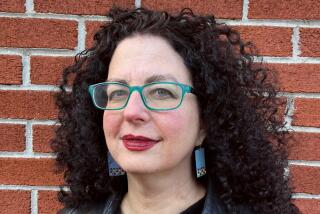‘The Street,’ a Poor Man’s ‘Miami Vice,’ From Newark
- Share via
NEW YORK — The New Jersey metropolis of Newark seems a strange place to do a police show. It’s not quite Miami, where they’ve got Don Johnson cops in Maseratis, pastel discos, terrible vice and 21-Uzi salutes.
Yet late last year, a troupe of actors and a small production crew with only one cameraman began trekking to Newark each night to make a television series that is almost as unusual as the idea of using Newark for a locale.
The show, created by two writers whose credits include “Miami Vice,” is “The Street,” intended for late-night broadcast Mondays through Fridays. It bows in Los Angeles at 11 p.m. Tuesday on KCOP Channel 13. (The station is showing a “sneak preview” of the series at 8:30 p.m. Sunday.)
Each episode is a half-hour ramble through the humdrum routine, the lowlifes and the occasional comedy and grief faced by two pairs of cops on squad-car patrol. Much of the view is from inside the squad car, with the camera serving as sort of an eavesdropper.
Each of the 40 episodes was shot at night on location, all of it on videotape, not film, for what “Miami Vice” might consider petty cash--about $60,000 per chapter.
Why Newark? “Because it’s an N.D. Eastern city,” joked co-creator Daniel Pyne, explaining that N.D. stands for nondescript. “Also, nobody’s ever shot (a show) there.”
Why videotape? “We wanted to make it look like the news,” said John Mankiewicz, his “Street” partner and perhaps the only TV writer around whose career dossier includes guitar time with Kinky Friedman’s band.
The idea, said Robert W. Pittman, the former MTV Networks chief who now heads Quantum Media Inc., maker of “The Street,” is to give the show the real, gritty look of news, with the camera as a participant.
It’s geared for young audiences, 18 and up, he added: “I think if anybody looked at this who is 55 years old, he’d say, ‘What’s going on, Mildred?’ ”
Pittman said the show’s initial run will be in 10 major markets, including New York. The hope is to develop a following, build word-of-mouth, get good reviews. Then Universal will decide whether a second batch of “The Street” should be taped and marketed to more stations. He said there probably will be a decision on a renewal in about two months.
“The Street” had its beginnings last year when Universal Studios, which bankrolled the series and is distributing it through MCA-TV, came to Pyne and Mankiewicz and asked them to create a low-budget cop show, Pyne said.
The two, who with Pittman share executive producer billing on the program, thought it a fine proposal, even though, as Mankiewicz said, partly in jest, “we took kind of a serious cut in pay.”
Pyne said it was a bit more fun than the big-time network sort of venture: “You get tired of emphasizing style over substance, and demographics over character.”
This series, he added, is not a “cop show” per se, but one about guys who happen to be cops and the effect of police work on them. The officers are portrayed by Bruce MacVittie, Ron Ryan, Michael Beach and Stanley Tucci.
“We wanted to do it because it was low-budget and we could fly”--try things that networks would nix, Mankiewicz said.
He wasn’t knocking network executives, he solemnly emphasized, “but that’s their job--to mess around with your show. And this was sort of flying under everybody’s radar, and we could make the show we wanted.”
A key player in the proceedings was the show’s cameraman, Rob Draper, who used a Sony Betacam, the same videocamera you see network and local TV news crews using to cover the day’s news.
Because virtually all of “The Street” was shot at night with very little lighting, “I made some very extensive modifications to the camera,” he said. “It sort of horrified Sony. They thought I was destroying the camera.”
Among other things, he said, he rigged it to go from the camera’s usual 125 ASA setting to 800 ASA--which basically let the camera shoot under light conditions that otherwise would mean Totally Dark Time on tape.
It made the taped images a little grainier, Draper said, and “it does take the edge off the technically perfect image” that networks want for broadcast, but that was in keeping with the gritty, realistic look of the show.
All his work was done with a hand-held camera, which posed a small problem after those in charge looked at the first day of taping.
“They said they were a little bit worried that it (his photography) was too steady, and could I shake it up a little bit?” Draper said, laughing. “It’s funny. You spend 15 years trying to develop very steady hand-held work, and then the first thing they do is tell you to shake it up a little.”
The nightly tapings in Newark, often done in freezing winter weather, made the usual pace of prime-time network filming--which can be exhausting--seem downright leisurely.
“We’d shoot one show in pretty much a day, as opposed to seven, eight, nine days for a ‘Miami Vice,’ ” Mankiewicz said. But then, he added, “The Street” is “more about who the characters are than what they’re driving.”
“It was great, in a way,” Pyne said of the production pace. “You didn’t have time to sit and brood.”
More to Read
The complete guide to home viewing
Get Screen Gab for everything about the TV shows and streaming movies everyone’s talking about.
You may occasionally receive promotional content from the Los Angeles Times.






